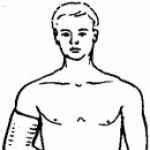), all that remains is to install the fastenings and train. The installation process is simple, but requires some skill. Therefore, we recommend contacting service center, where professionals will install fastenings quickly and efficiently. If you still want to do it yourself, then let's start.
Installing bindings on roller skis is practically no different from installing bindings on skis. To install bindings on roller skis you need the same set of tools as for installing on regular skis:
1. Special jig or template for installing fasteners
Conductors under various systems mounts are different, be sure to pay attention to this (SNS and NNN). The jig for installing mounts on roller skis is shorter than for installing skis.

2. Drill for installing fasteners
On sale you can find special drills with a stop, for example Rottefella 3.7 mm drills for skis and 4.1 mm for metal roller skis. If you don’t have a special drill, then a regular metal drill will do. Many sources recommend installing fasteners with a 4 mm drill, but from experience we recommend 4.5 mm. Screws fit into such holes more easily and hold tightly. If there is only a standard Rottefella 3.7 or 4.1 mm, then it is better to widen the holes by placing the drill at an angle. You can lubricate the screw with any household lubricant or machine oil, some recommend using ski grip wax. Otherwise, it will be very difficult to screw in the screw.
note that NIS platforms come with screws bigger size and it is better to drill 5 mm holes for them.

3. Screwdriver and screwdriver for tightening

On the left is the PH standard, on the right – PZ

1. Unlike skis, you don’t need to look for balance on roller skates. The mounts are placed so that the heel of the boot is close to the mudguard of the rear wheel.

2. We attach the fasteners to the frame of the roller skate and mark the front hole or axis of the boot. If it is more convenient, you can mark the hole for the heel and set the template along it.
3. Install the jig according to the markings and drill the required holes.
4. Screw in the mount. The screws go into the metal very tightly - this is normal..
Advice:
On the bindings it is better to change the flexor to Hard, and on the SNS pilot increase the spring force so that the roller does not sag too much from the heel of the boot.

Roller skis are roller skis. By analogy with roller skates, they are intended for skating on asphalt, for summer training of skiers, and for competitions. Among fans of roller skiing there are both beginner amateurs and professional athletes.
Marking
A pair of roller skis consists of two platforms with rollers attached to them. The rollers themselves are equipped with mudguards. New roller ski bindings often come separately and can be classic or skate. Self-installation fastenings begin with markings. Attach the ski binding assembly to the platform so that the widest part of the binding sole is aligned with the middle of the roller platform. If you are attaching classic bindings for classic running, butt the fastenings to the rear mudguard. After this, mark the location for screwing in the front mounting screw.Some models of roller skis are sold already marked for installation of bindings. Typically they contain two sets of screw marks. The first is for large size shoes (more than 40), the second is for small shoes (size less than 40). It is better to install fasteners using a special template to ensure maximum accuracy.
Fastening
Before screwing in the screws, pre-drill holes for them. For drilling, use a drill with adjustable speed and drill bits that provide required diameter and hole depth. If you have access to specialized equipment, use a special drill with an extension. It ensures that the drill is centered in the drill and stops at the required depth. When using a standard drill, use drills with a diameter of 3.4-3.6 mm. If drilling occurs with the help of a brace, the use of a jig is mandatory: without it, the drill often moves to the side.For fastening, use the self-tapping screws included with the fasteners. Although they are difficult to twist, they hold securely and firmly. Before screwing in, the screws can be moistened with machine oil to reduce the force applied to the screwdriver. Unlike skis, drilling holes in rollerblades must be done with the utmost care. While an erroneous hole in skis can be sealed with a plug, this cannot be done on roller skates. To drive screws, you can use screwdrivers with PH 3 or PZ 3 bits.
Many athletes use alternative method screwing fasteners using countersunk head screws type M4x25. The screwing points are marked with a stencil, the lower part is drilled out for steel hollow T-shaped pistons. The pistons are inserted from below and countersunk screws are screwed into them. Unlike self-tapping screws, although this method is more labor-intensive, it is much more accurate and reliable when using rollers intensively. This option is also ideal for those who have already unsuccessfully drilled holes for self-tapping screws.
Frame
The frame transmits force from the leg to the wheels. The main characteristics of the frame are length, rigidity and weight. The longer the frame, the more stable the rollerski stays on course when rolling, but at the same time the controllability decreases. Long frames also dampen vibration better. As a rule, skate roller skis have a frame length of about 60-65 cm, and classic roller skis have a frame length of more than 70 cm. Frame length or wheelbase (the distance between the front and rear wheel axles) also affects control and balance. The longer the base, the more linear the movement, therefore it is easier to maintain balance and vibrations are dampened more. The frame can be rigid and flexible.
Flexible frames
are calculated in such a way that when pushing and rolling, they correspond as closely as possible to the operation of a real ski. These roller skis are designed for training in skiing technique. Additional property The flexible frame is able to dampen wheel vibrations well, so riding on such roller skates is most comfortable and they are suitable for long-term training. But flexible frames are less reliable. When choosing roller skis with a flexible frame, it is necessary to take into account that, unlike skis, the rigidity of all roller skis is calculated for a certain average skier weight corresponding to 60-70 kg. A skier with a lot of weight can push through or break such a frame. If the frame is made of plastic or composite material, when the frame comes into contact with the asphalt, scuffs and scratches appear, which over time can lead to failure.
Rigid frame
is the exact opposite of flexible. Made from aluminum alloy These frames have almost absolute reliability; a rigid frame is better controlled, but at the same time, during movement, the athlete’s foot is subjected to greater vibration loads. Rigid frames are used in racing and high-speed roller ski models.
Wheels
Wheels are one of the key components of roller skis. Two types of materials are used to make wheels: polyurethane and rubber.
Rubber has good elasticity, which ensures riding comfort, as it effectively reduces vibration and vibrations transmitted from road unevenness. Rubber wheels have good grip on asphalt surfaces, but can significantly reduce driving speed. That's why rubber wheels It is better to use it on roller skis for a classic ride. When installed on skate skates, rubber wheels can become too sideways when pushed too hard, causing unnatural deceleration and sometimes damage to the wheels. High wear of rubber during skating also limits its use.
Polyurethane wheels, as a rule, have greater rigidity than rubber ones. Polyurethane wheels react more sensitively to lateral impacts and are less susceptible to wear. Good quality polyurethane guarantees excellent handling and grip on asphalt.
Bearings
Roller skis are roller skis. By analogy with roller skates, they are intended for skating on asphalt, for summer training of skiers, and for competitions. Among fans of roller skiing there are both beginner amateurs and professional athletes.
Marking
A pair of roller skis consists of two platforms with rollers attached to them. The rollers themselves are equipped with mudguards. New roller ski bindings often come separately and can be classic or skate. Self-installation of fasteners begins with markings. Attach the ski binding assembly to the platform so that the widest part of the binding sole is aligned with the middle of the roller platform. If you are attaching classic bindings for classic running, butt the fastenings to the rear mudguard. After this, mark the location for screwing in the front mounting screw.Some models of roller skis are sold already marked for installation of bindings. Typically they contain two sets of screw marks. The first is for large size shoes (more than 40), the second is for small shoes (size less than 40). It is better to install fasteners using a special template to ensure maximum accuracy.
Fastening
Before screwing in the screws, pre-drill holes for them. For drilling, use a drill with adjustable speed and drill bits that provide the desired diameter and depth of the hole. If you have access to specialized equipment, use a special drill with an extension. It ensures that the drill is centered in the drill and stops at the required depth. When using a standard drill, use drills with a diameter of 3.4-3.6 mm. If drilling occurs with the help of a brace, the use of a jig is mandatory: without it, the drill often moves to the side.For fastening, use the self-tapping screws included with the fasteners. Although they are difficult to twist, they hold securely and firmly. Before screwing in, the screws can be moistened with machine oil to reduce the force applied to the screwdriver. Unlike skis, drilling holes in rollerblades must be done with the utmost care. While an erroneous hole in skis can be sealed with a plug, this cannot be done on roller skates. To drive screws, you can use screwdrivers with PH 3 or PZ 3 bits.
Many athletes use an alternative method of screwing in fasteners using M4x25 countersunk head screws. The screwing points are marked with a stencil, the lower part is drilled out for steel hollow T-shaped pistons. The pistons are inserted from below and countersunk screws are screwed into them. Unlike self-tapping screws, although this method is more labor-intensive, it is much more accurate and reliable when using rollers intensively. This option is also ideal for those who have already unsuccessfully drilled holes for self-tapping screws.
Attention, TODAY only!
Everything interesting
Often it becomes necessary to screw a screw into concrete wall. In this case, you need to know that the screws are fastened into dowels. The work is labor-intensive, but doable, so don’t be intimidated by its complexity. Concrete and reinforced concrete are the most popular…
When performing various repairs and construction work Often there is a need to make a large diameter hole in metal or plastic. When drilling large holes, a number of difficulties arise. If you buy enough...
Slate is very firmly embedded in modern construction. This one is easy to install, quite durable and inexpensive material took its place in the market roofing materials. But in front of everyone positive qualities and popularity, it is quite fragile and...
Installing a sink yourself does not require special knowledge and skills, and almost anyone who knows how to use a hammer drill and a screwdriver can do it. Although installation details depend on the washbasin model,…
Screws are used quite often in housework and construction. The popularity of this type of fastening is associated with the convenience of attaching parts to wooden base. A special type of screw is a self-tapping screw or self-tapping screw, which differs from...
The screw is fastener, which is used to connect various surfaces. Structurally, the screw consists of a head with a slot, a threaded rod and a threaded tip. The material used for making screws is low carbon steel...
As a rule, most sports stores provide a professional installation service for bindings. But if, for one reason or another, you don’t want to resort to the help of specialists, you can try installing bindings on your skis...
For small skiers, the most optimal option is to install semi-rigid ski bindings. A child who has recently started skiing moves slowly and unsteadily and, as a result, often freezes in the process. skiing. Semi-rigid mounts...
When purchasing new skis, you have to deal with installing bindings on them. In stores, of course, they offer to install bindings on purchased skis, but this is associated with additional costs. Installing the fastenings yourself is not that difficult...
Ski bindings can be divided into two categories: rigid and semi-rigid. To use hard ones, special boots are required. By installing semi-rigid ones, you can ski in regular shoes. You will need - skis; - a set of semi-rigid...




